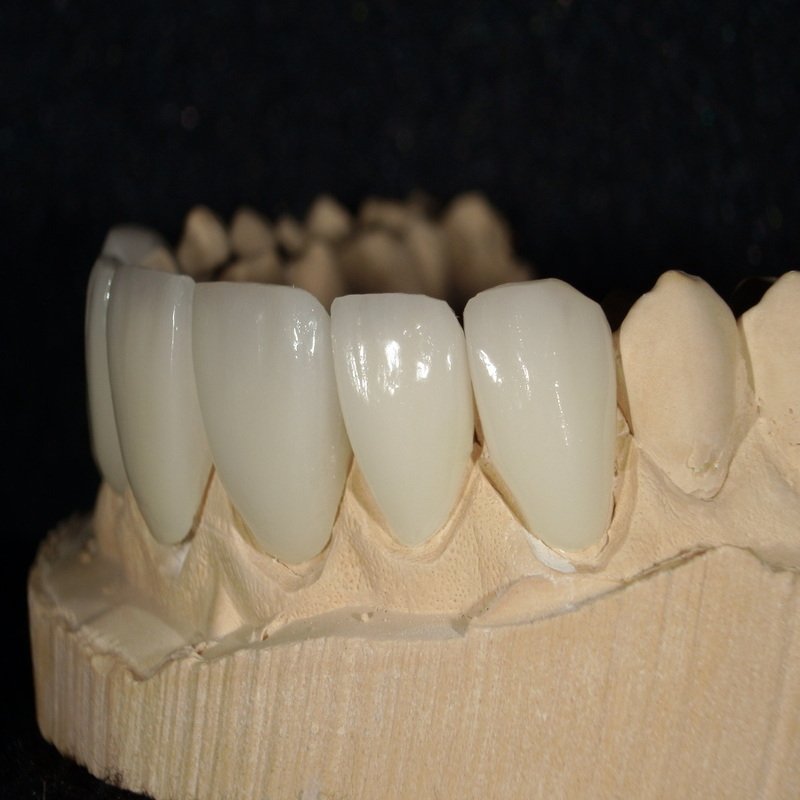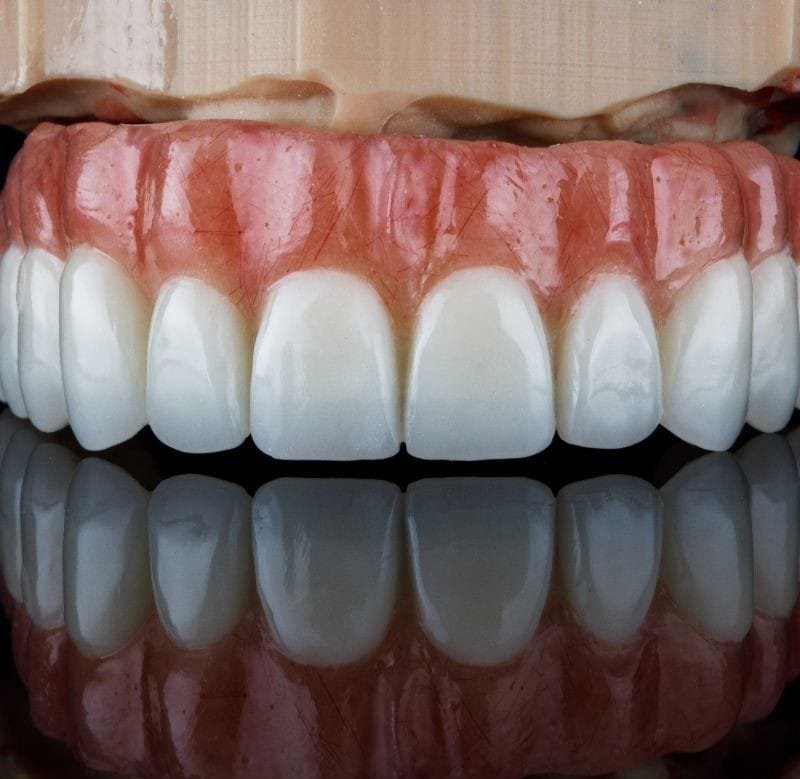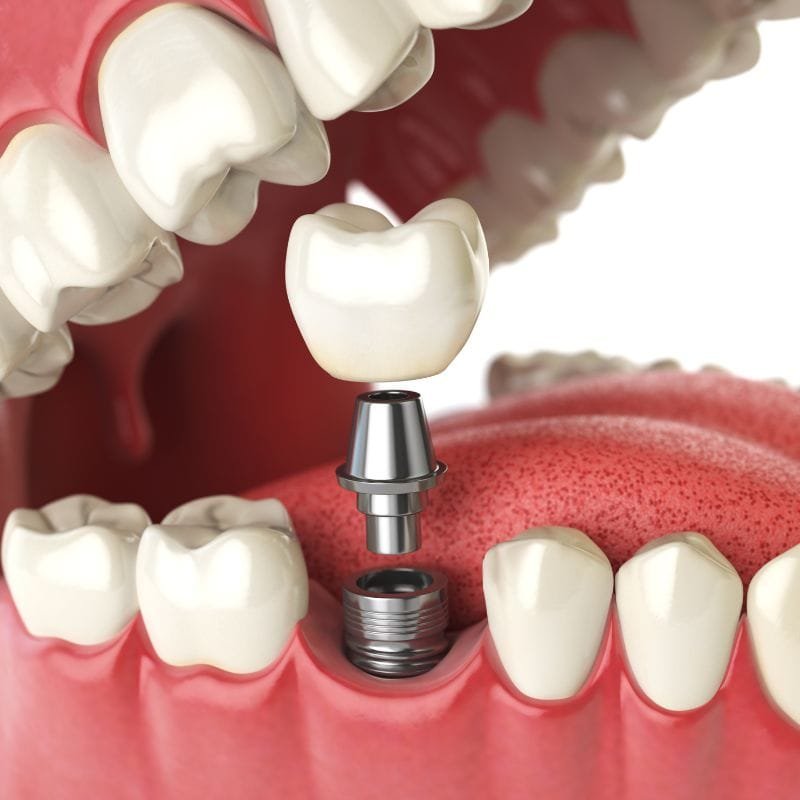What are the teeth names and numbers?
A set of adult teeth has teeth names and numbers based on their arch, class, type, and side. On the other hand, children have 20 primary teeth and start to grow their first actual teeth by the age of 6. Humans have two sets of teeth: primary or baby teeth and permanent or adult teeth. The collection of teeth that replaces primary teeth is called a succedaneous or permanent dentition dental numbering system. Understanding teeth names and numbers helps dentists and patients communicate effectively about oral health and treatments.
It’s recommended that children see a dental professional as soon as they turn one year old. A dentist can better explain teeth names and numbers so you can identify them. See a dentist if your child does not start to get teeth within the year. The first visit will get your child familiar with the dentist. Healthy development is vital to appropriately developing the child’s nutrition and speech.
Teaching them helps develop lifelong oral health habits that apply to adult teeth. For most parents, by the age of 7, the child will start to lose their baby teeth. They are making space for the child’s front teeth to come in. Dentists use teeth names and numbers to identify each tooth, simplifying diagnosis and treatment planning. For instance, the “right maxillary first molar” refers to the first molar in the upper right quadrant. These identifiers are invaluable for tracking dental health across a lifetime.
The four classes of teeth include incisors, canines, premolars, and wisdom teeth.
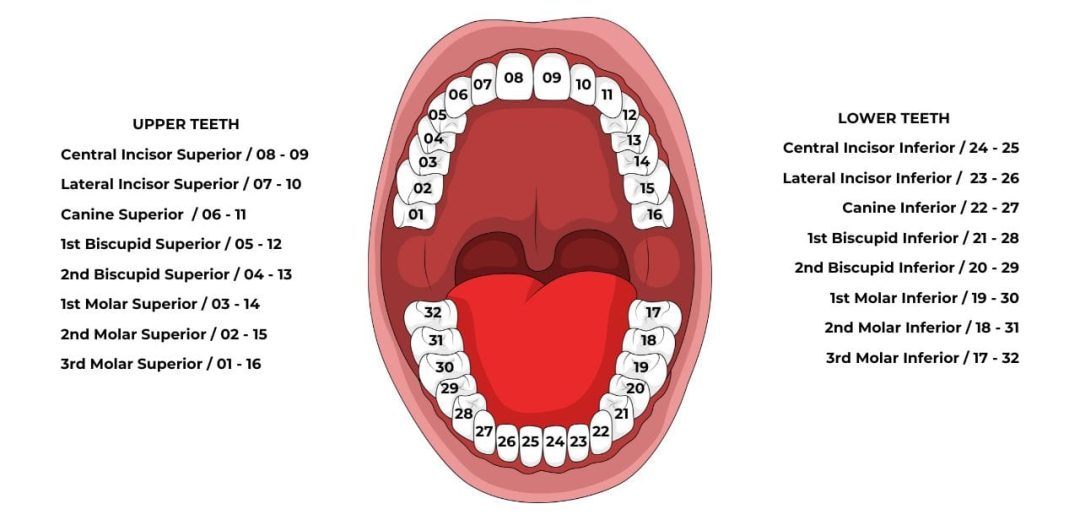
Why Are Teeth Names and Numbers Important?
Teeth names and numbers provide a universal language for dental professionals. This standardized system ensures precision in diagnosis and treatment, reducing misunderstandings. For example, dentists often refer to the “six-year molar” to describe the first permanent molar that erupts around age six. Similarly, wisdom teeth, or third molars, are numbered 1, 16, 17, and 32 in the American Dental Association’s universal numbering system.
Patients also benefit from understanding their teeth’ names and numbers. Knowing which tooth requires attention can foster better communication during dental appointments. For instance, if a dentist mentions issues with the “left mandibular second premolar,” the patient can pinpoint the tooth needing care.
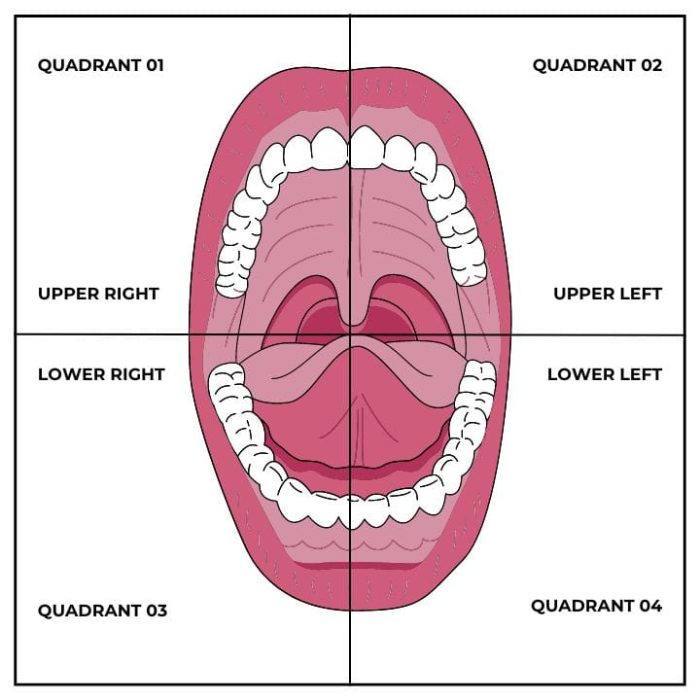
Each tooth serves a unique function
Canine Teeth: Canine teeth, also called cuspids, sit on either side of the incisors. They work with the incisors to bite and tear food.
Lateral Incisor: The four lateral incisors sit next to the middle incisors, two on each arch. These teeth have sharp edges that help tear food.
Central Incisor: The middle incisors are the front teeth. Adults have four central incisors: two on the upper and two on the lower arches. These teeth have a chisel shape and cut food efficiently.
Premolars: Premolars, or bicuspids, are the eight teeth next to the canines. These teeth are smaller than molars and have two cusps that crush and tear food.
Molars: Molars are larger teeth with four cusps located at the back of the mouth, behind the premolars. Adults typically have 12 molars, six on the upper arch and six on the lower. Molars have broad, flat surfaces for chewing and grinding food.
Wisdom Teeth: Wisdom teeth are the last molars adults develop. These teeth erupt during the teen years but can appear later. They are located in the upper and lower arches, with two on each side. Not all wisdom teeth need removal, but some may require extraction due to infection, overcrowding, or misalignment. Trust Dental Care can help plan for their removal if necessary.
The position and name of each tooth in the mouth make it easier for dentists to identify them during treatment.
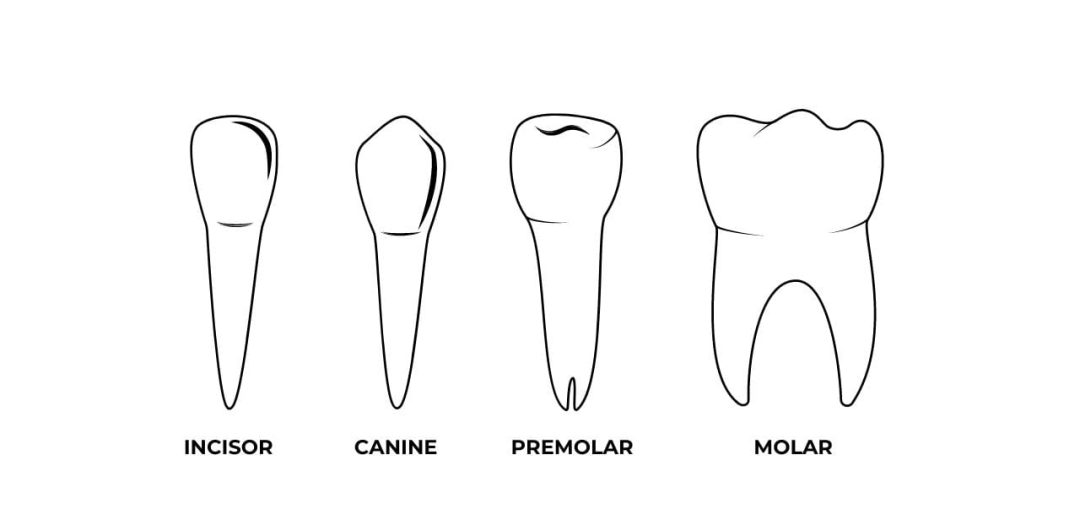
Teeth Names and Teeth Numbers in Human Mouth
Humans have 32 teeth, including the third molars, or wisdom teeth. Dentists assign each tooth a name based on its shape, position, and sometimes a specific number or letter to ensure precise dental care and avoid confusion. For example, “right mandibular second molar” indicates the second molar on the right side of the lower jaw.
Teeth line up symmetrically in the mouth, and understanding their names and numbers benefits both patients and dentists. Dentists standardize tooth names in English, calling canines “canines” and premolars “bicuspids.”
Dentists also use age-based terms for permanent molars. They call the upper first permanent molar the “six-year molar,” while the second is the “twelve-year molar.” Wisdom teeth, or third molars, emerge later in life.
Teeth at the front—incisors, lateral incisors, and canines—are called anterior teeth, while premolars and molars at the back are called posterior teeth.
*mandibular* refers to teeth in the lower jaw, while *maxillary* refers to those in the upper jaw.
Diagram of Teeth Names and Numbers
Humans have 32 teeth, including the third molars, or wisdom teeth. Dentists name each tooth based on its shape, position, and sometimes a specific number or letter to avoid confusion and ensure precise dental care. For instance, “right mandibular second molar” indicates the second molar on the right side of the lower jaw.
Teeth are arranged symmetrically in the mouth, making their names and numbers useful for patients and dentists. Dentists typically standardize tooth names in English; for example, they refer to canines as canines and premolars as bicuspids.
Dentists also use age-specific names for permanent molars. They call the upper first permanent molar the “six-year molar,” while the second is the “twelve-year molar.” Third molars, or wisdom teeth, emerge later in life.
Teeth at the front of the mouth—incisors, lateral incisors, and canines—are anterior teeth, while premolars and molars at the back are posterior teeth.
The term *mandibular* describes the teeth in the lower jaw, and *maxillary* refers to those in the upper jaw.
Teeth Names and their functions
Human teeth are named based on their functions, appearance, and specific roles. Teeth fall into four categories, each with a unique shape that supports a specific function.
As omnivores, humans consume both plants and meat, requiring different types of teeth. Incisors, or cutting teeth, slice food into smaller pieces, helping to move it inward. Canines, also called eye teeth or cuspids, have sharp, pointed edges that help with chewing, grinding, piercing, and ripping food.
Functional names help dentists simplify their work since each tooth’s role aligns with its shape and purpose.
Fun fact: Teeth numbered 1, 16, 17, and 32 are wisdom teeth. This numbering system, sometimes called the American Dental System, originated in the United States, according to Wikipedia.
There are different kinds of actual teeth
Canines: Also called cuspids, canines are the pointed teeth next to the incisors. These teeth work with incisors to bite and tear food efficiently.
Lateral Incisors: Each dental arch has two lateral incisors, one on each side, beside the central incisors. These teeth feature sharp edges designed for tearing food.
Central Incisors: Adults in the front of the mouth have four central incisors—two on the top and two on the bottom. Shaped like chisels, they are ideal for cutting food.
Premolars: Premolars, or bicuspids, are located next to the canines—two on each side of the mouth, with four on the top and four on the bottom. Slightly smaller than molars, they have two cusps for crushing and tearing food. The first premolars are closest to the incisors, while the second pre nearest to the molars.
Molars: Molars are the large, flat-surfaced teeth at the back of the mouth, situated behind the premolars. Adults have 12 molars, with six on each arch (three on each side). Molars have broad surfaces for chewing and grinding food.
Wisdom Teeth are the last four molars, located in the far back of the mouth—two on top and two on the bottom. They often emerge during the late teens but can appear later. Though not all wisdom teeth require removal, dentists may recommend extraction to prevent infection, crowding, or misalignment.
How many teeth do humans have: names, functions, and development
Incisors are the eight front teeth, with four on the top and four on the bottom. The two teeth in the center are called central incisors, while the ones on either side are known as lateral incisors. Their primary function is to bite into food. Babies typically grow their first incisors around six months of age. When these baby incisors fall out, usually between ages 6 and 8, the permanent incisors take their place.
Canines are fast teeth placed outside the incisors. Adults and children have four canines, two on the top and two on the bottom, to tear their food. Canine’s primary appears when a kid is approximately 16 to 20 months old. The actual lower canines come in at around ten years old, and top canines erupt between 11 and 13 years old.
Premolars, also knew as bicuspids can tear and chew food. They are somewhat flat with ridges on the peak, and there are four on each side—the premolars developed by approximately 10 to 11 years of age.
Molars also grind and chew food, they work better to grind food than the premolars, and the job with the tongue to swallow food. These 12 teeth are placed in the mouth back, and they start to appear in kids at approximately 12 to 15 months old. Then the actual molars come in, first at approximately six years old, and the second molars rise in children between 11 and 12 years old.
The 5th type of tooth is the 3rd molar also referred to as wisdom tooth. People grow 3rd molars at approximately age 18 or 25 if they grow them at all. Many people have them removed if they cause or pain in the mouth. In case you need a tooth extracted, consult a dentist.
Humans have 32 permanent teeth. the number 32 is limit for tooth human
Teeth Names and Cosmetic Dentistry
Understanding teeth names and numbers is also essential in cosmetic dentistry. Procedures like veneers, crowns, and dental implants are tailored to specific teeth, improving both function and aesthetics. For instance, a chipped incisor can be restored with a porcelain veneer, while a missing molar may require an implant to maintain proper alignment and chewing efficiency.
Modern cosmetic dentistry offers solutions for various dental concerns, from minor imperfections to complete smile makeovers. At Trust Dental Care, we specialize in enhancing your smile while preserving the natural function of your teeth. Whether you’re interested in whitening, bonding, or orthodontics, our team is here to help.
Make an Appointment
It is paramount to keep your care of your teeth clean with fluoride toothpaste at least two times a day. It is especially vital to clean before you go to bed. The top way to brush is to move in small circles, go around until you have covered every side of every tooth. You should clean the space between teeth by flossing once a day. It removes plaque and food that get stuck between them.
To maintain optimal health, you need to see your, dentist, every six months to prevent long-term diseases. We hope you learned about teeth numbers and teeth names.
If you have any questions, contact us, or call us at (619) 860 6060, we are here to help you!
